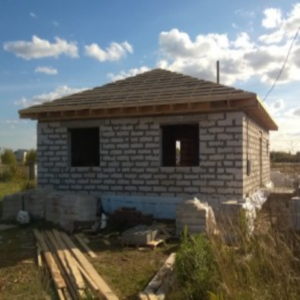The Growing Popularity of
Bio-Based Spray Foam Insulation

The agricultural and forest industries both produce residues or waste streams that have little or no economic value. The challenge that remains for agricultural and forestry residues is how to best utilize this material for maximum efficiency and economic profit. A few years ago I received $250,000 from the USDA to examine the suitability of a rapidly-developing new technology known as continuous microwave-assisted liquefaction to convert this under-utilized material to bio-polyols for the production of spray-foam insulation. Liquefaction is a process that can be used to dissolve biomass in an organic solvent (also called a reagent solvent) at moderate temperatures (120 to 250 ºC) with or without acid catalysts (Hse et al. 2011; Pan 2007; Pan et al. 2012). Liquefied biomass can be concentrated and used as a raw material for other value-added products such as polyurethane foam, epoxy resin or phenolic resin depending on the reagent solvent used in the liquefaction (Pan 2007). Our application of microwave technology to the liquefaction process has received a U.S. patent (#8,043,399) and has been shown to dramatically improve the liquefaction rate, shorten the reaction time, lower operational temperature, and use less chemical input as compared to traditional liquefaction reactions (Hse et al. 2011).
Spray-foam insulation is growing in popularity as a type of insulation for residential and commercial housing. Spray-foam is a substitute for traditional fiberglass insulation. The chemical agent is stored in canisters and sprayed with a special application device; it then expands and dries, forming a barrier. The advantage of foam insulation is that it expands and leaves no gaps as is the case with typical fiberglass insulation. Therefore, there are no pathways for air to escape – thus an efficient vapor barrier is established. The foam also prevents the buildup of moisture, lowering the incidence of mildew and mold problems, and makes it more difficult for insects and other pests to burrow into a building. Spray-foam insulation is recognized as an important part of the wall component in ‘green’ buildings, and also is one of the fastest growing areas in building products. These advantages and the “green” aspect of foam insulation can be rolled into one with the development of spray-foam insulation from liquefied biomass to attain a new renewable and sustainable product.
Meet the Author
Dr. Todd Shupe is the President of Wood Science Consulting, LLC. He is a well-recognized expert on wood forensics, wood preservation, wood decay and degradation, and wood species identification. He has a broad background in new product development, quality management, and marketing and sales in both the public and private sectors. For more information please visit DrToddShupe.com.
We welcome your comments below.
Thank you for visiting. We trust that you have enjoyed reading our articles.
Liked this post? Read more below or search for more topics . . .

